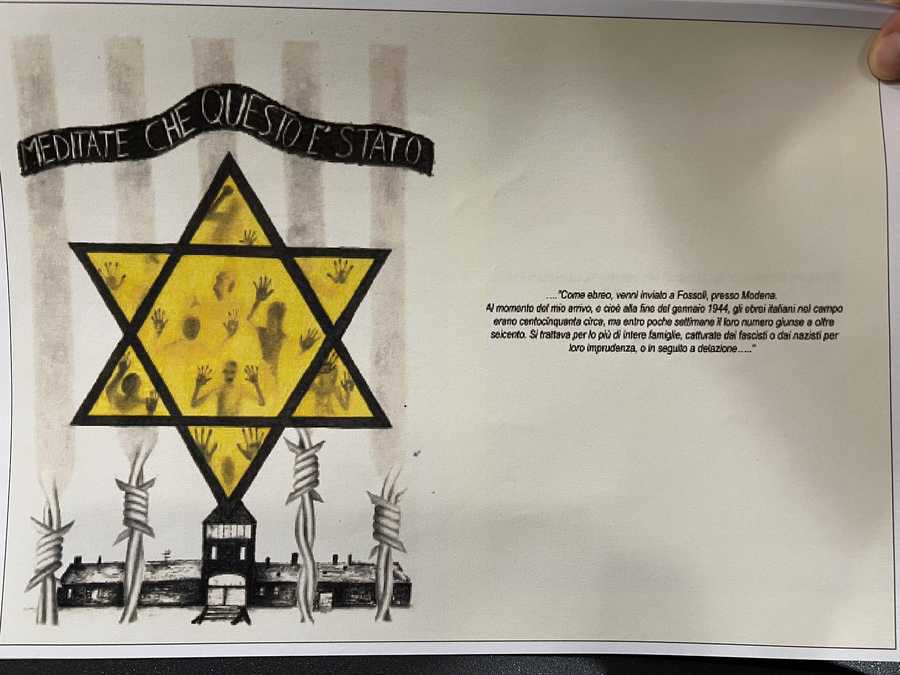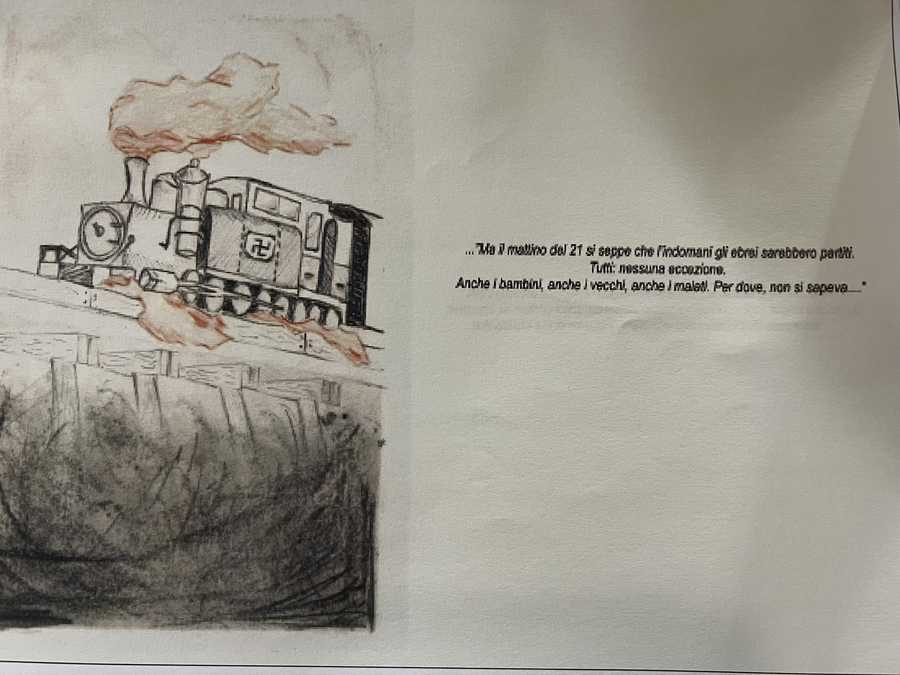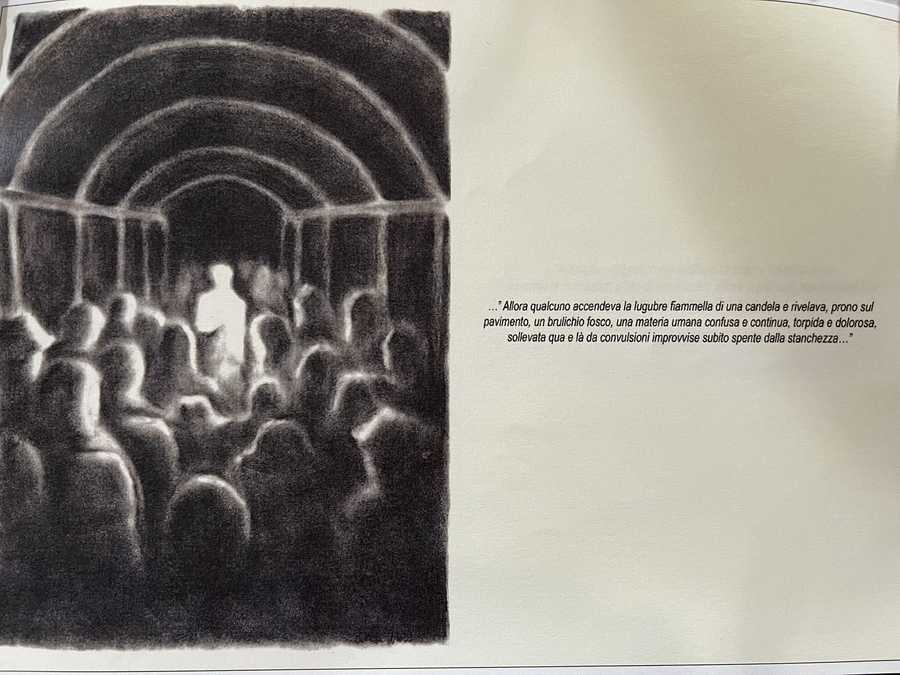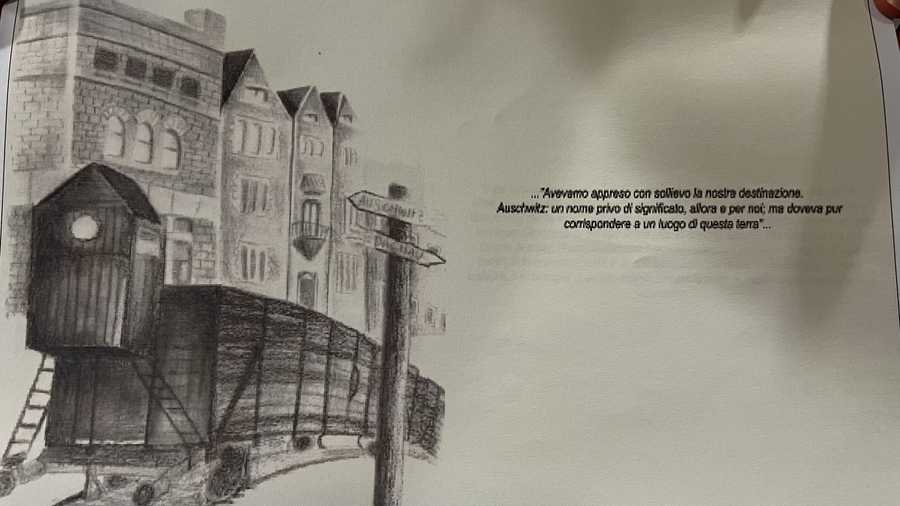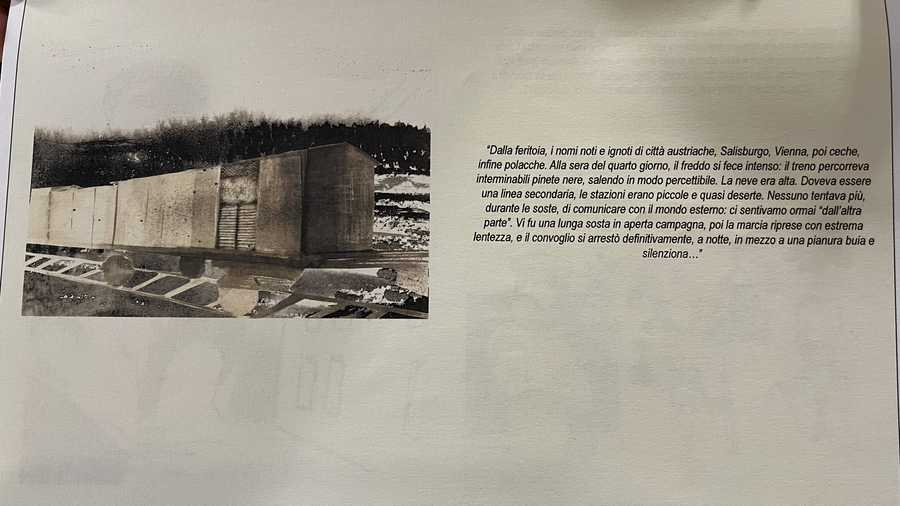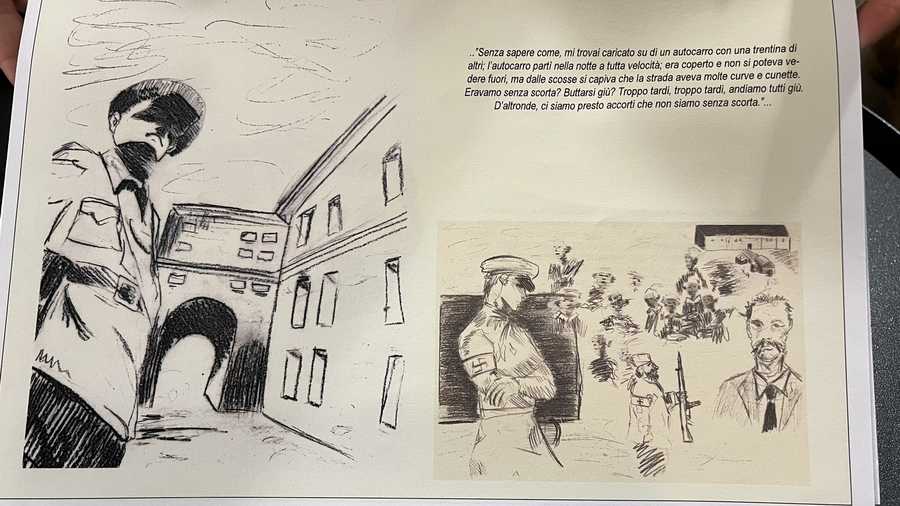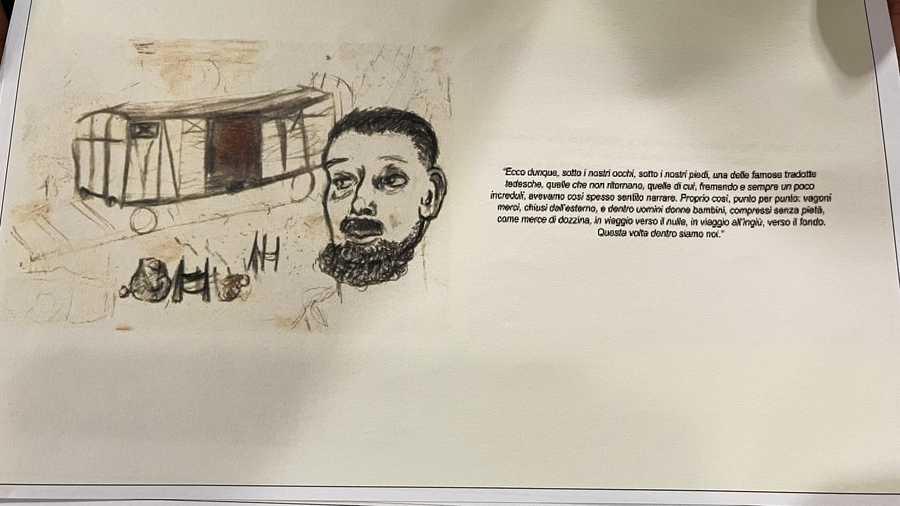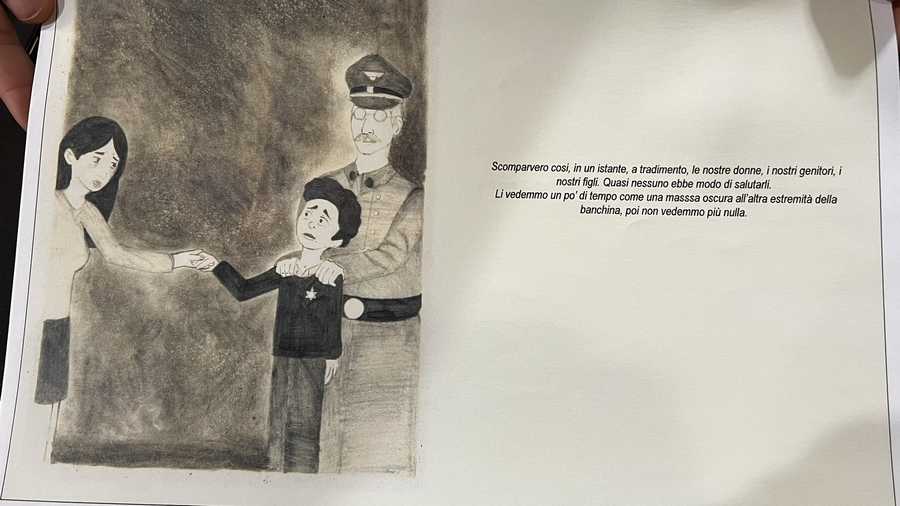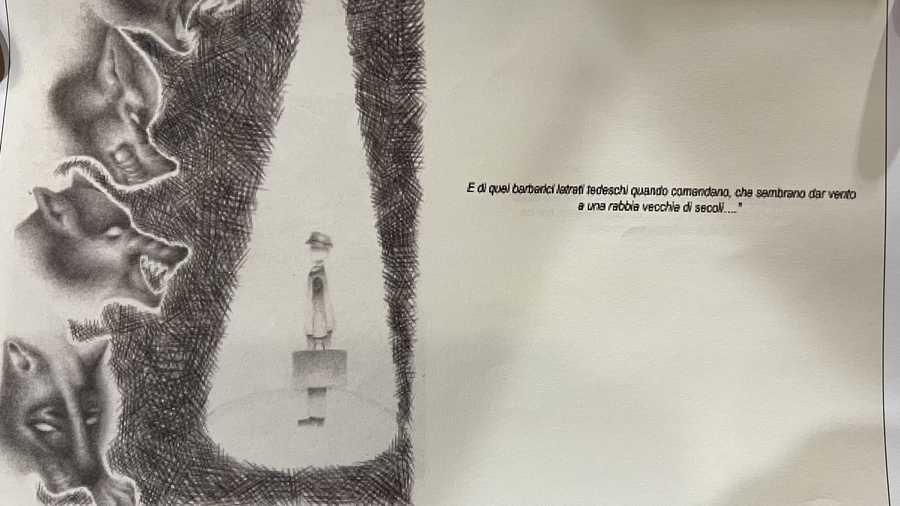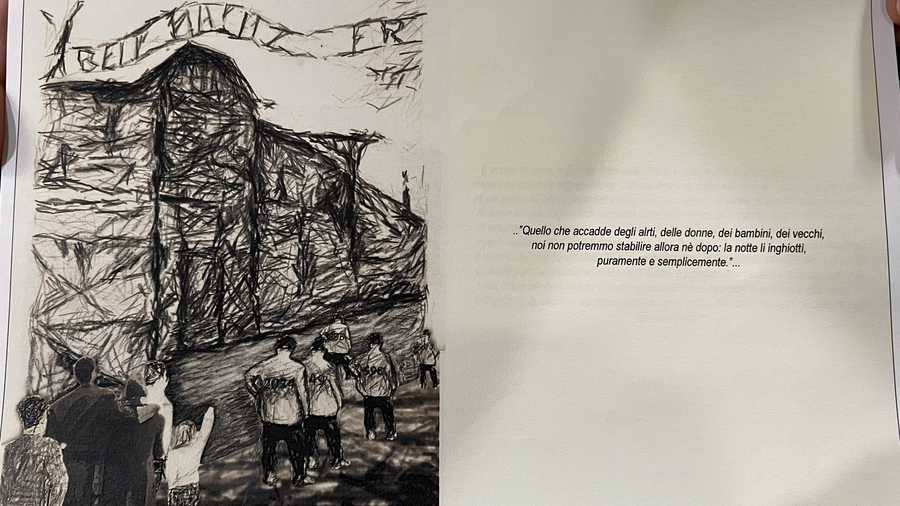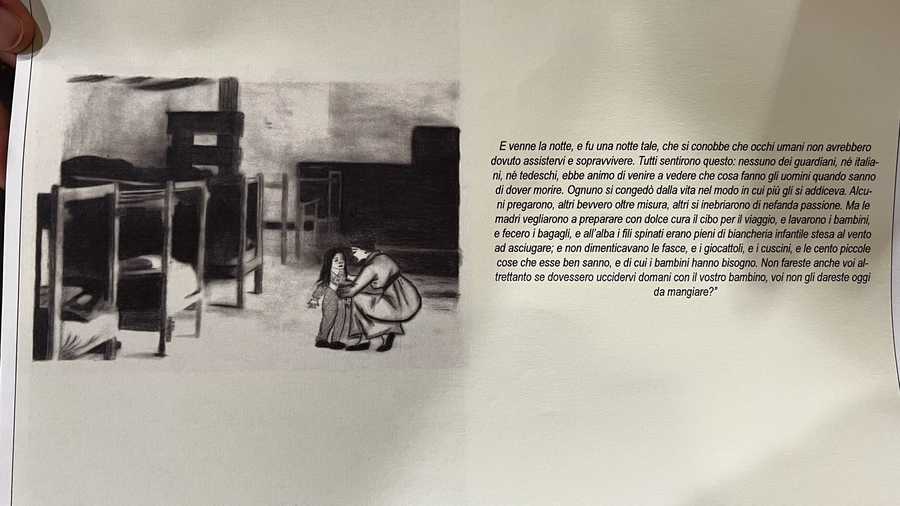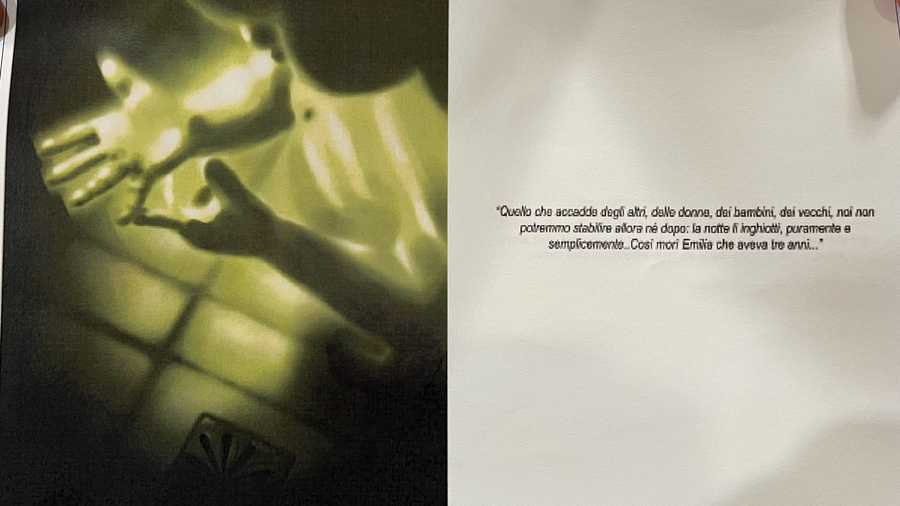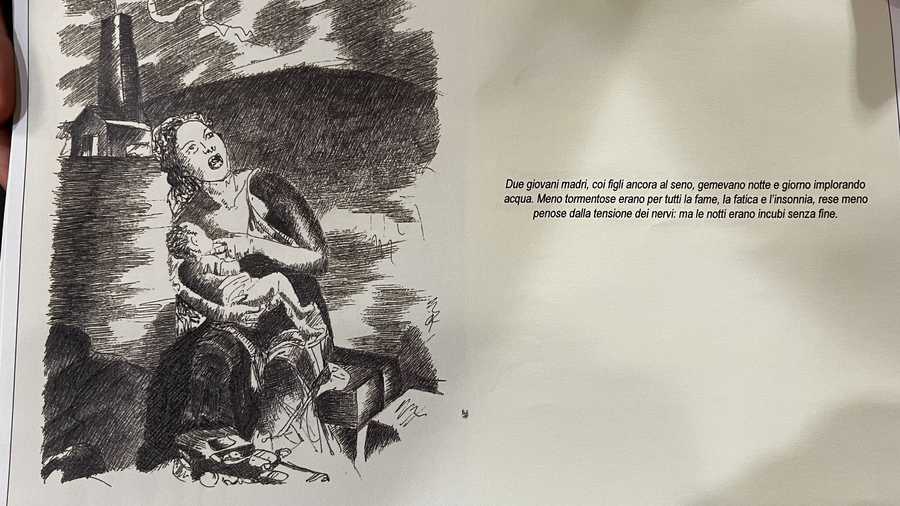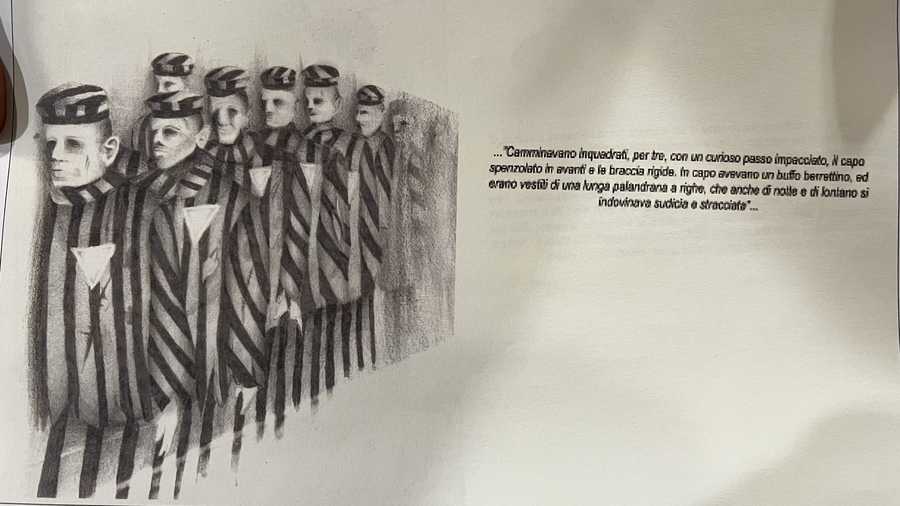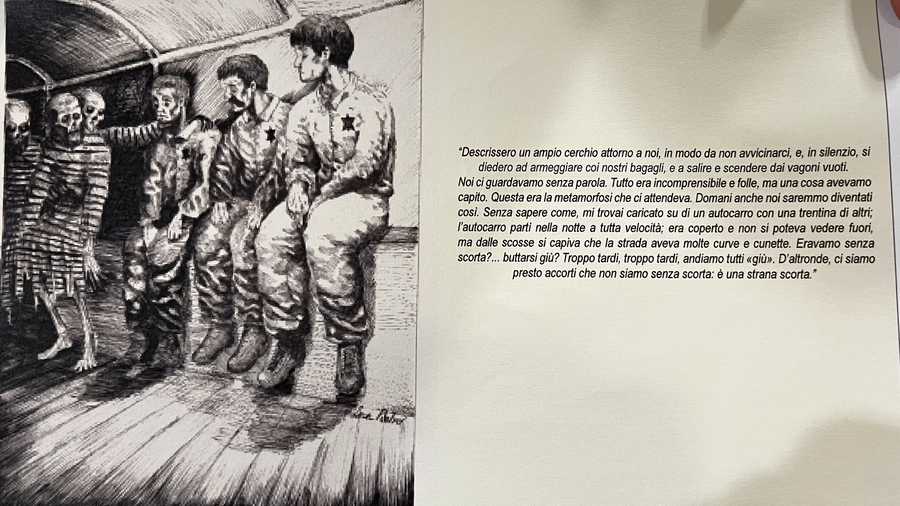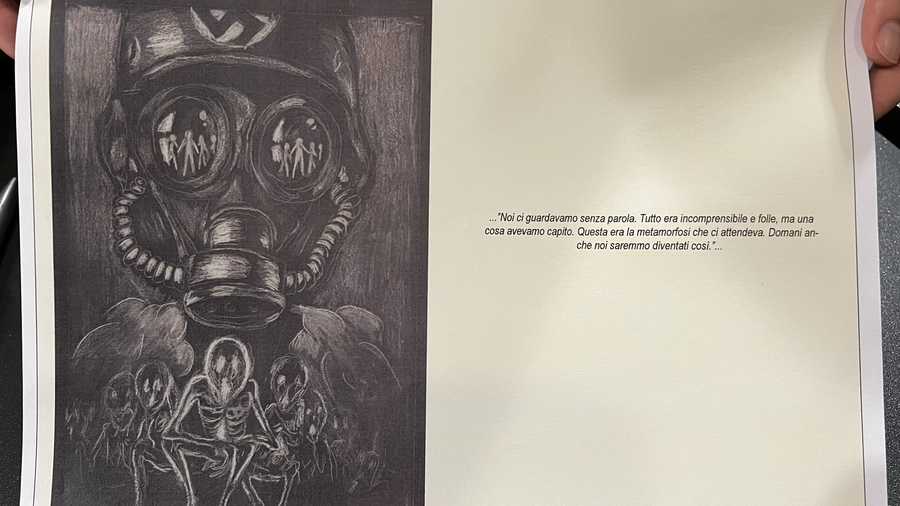Andra Bucci finally became a United States citizen in 2023 at the Placer County Fairgrounds in Northern California.The newly naturalized Italian American from Sacramento said she slept very little ahead of the ceremony out of sheer excitement. She clapped and laughed as she marked the start of a new chapter in her life. When asked if she got a nice picture, she responded by saying her naturalization ID photo looked more like a picture an inmate would take. Andra would know. She and her sister Tatiana Bucci survived the Holocaust, the systematic mass murder of 6 million Jewish people during World War II.The sisters were young children when they were placed into Birkenau, the portion of the Auschwitz concentration camp complex that focused on exterminating Jews. Andra was 4 years old, and Tatiana was 6. Surviving filled Andra's life with purpose. Andra, now 85, has spent her life educating others about the Holocaust to make sure that history is not lost to time. She's returned to Auschwitz nearly 40 times on "memory trips" with students.KCRA 3 spent five years learning about Andra and Tatiana Bucci's tale of survival, which involved a mother's genius, the luck of being mistaken for twins, the kindness shown by someone who was cruel to others and the daughter of Sigmund Freud. Our documentary "Always Remember Your Name" also shines a light on Italy's lesser-known involvement during the Holocaust in persecuting Jews. Watch the full documentary in the video at the top of this story. App users, click here for the best digital presentation of this article. Below, you'll find photos shared by the Bucci family, interactive maps and graphics detailing Italy's history during World War II and resources to continue learning about the Holocaust.Remembering Italy as an Axis PowerItaly's connections to WWII and the Holocaust go back to 1922, well before the displacements and killings of Jewish people began. This was the year Benito Mussolini and his Fascist followers marched on the city of Rome to gain power. This led King Victor Emmanuel III of Italy to appoint him prime minister of the country.In 1933, Nazi leader Adolf Hitler became chancellor of the German government. After this, Italy, under the leadership of Mussolini, would align closer with Germany's antisemitic stances under the Third Reich.Beginning in 1938, Italy's Fascist government took multiple actions against Jewish people. It first published what is called the "Manifesto of Race" on July 14, setting the stage for a series of antisemitic laws to follow. On Aug. 22, the country held a "Special Census of the Jewish Population." This was explained as a way to keep track of immigrant Jews but ultimately it would help keep track of Italian Jewish people and lead to property confiscations, arrests and more.At the start of September, the Italian Council of Ministers approved the first set of anti-Jewish provisions in the country and approved another set of anti-Jewish provisions in early October.These provisions were heavily inspired by Germany's own restrictions, better known as the 1935 Nuremberg Laws.This led to many restrictions for Jewish people in Italy, according to Shira Klein, the department chair of history and chair of the history department at Chapman University. Some of those restrictions included not being allowed to go to the seaside and not being allowed to advertise or publish. They also could not marry non-Jewish Italians. They were restricted from certain jobs and faced limits on property ownership. "You name the restriction — it probably existed," Klein said.By June 10, 1940, Italy had joined the Axis Powers of Germany and Japan in World War II, months after Germany began rounding up Jewish people throughout German-controlled territories.See a full timeline below of WWII and the Holocaust as it relates to the Andra and Tatiana Bucci. Can't see it? Click here.On July 25, 1943, Mussolini was dismissed from office and arrested after the Allies took control of southern Italy. But with the help of Germany, he retook control of northern Italy in mid-September of that year and created a Fascist government called the Repubblica Sociale Italiana.Later that year on Oct. 16, German SS officers, along with Italian police, began rounding up Jewish people in Rome, with a focus on those living in the Jewish ghetto. Troops rounded up more than 1,000 Jews in all.The Nazis searched every car and home and ordered people to take their luggage and valuables with them. At the time, Fiume, located in modern-day Croatia, was part of Italy. That is where the Bucci family was when the Germans came for them as well.Andra's grandmother pleaded with the Nazis to leave the children and take her instead. They did not listen and took the family to a cell in a rice-husking factory.On Nov. 30, 1943, Italian police were tasked with rounding up Jews and delivering them to the Germans. From there, Germany would deport them to Auschwitz.Dispelling the myth of the "good Italian"Despite Italy's role in the deaths of millions, the country is often seen as a victim.Klein explained that there is a belief that Italy was a neutral area and that Germany dragged Italy to war.There is also the myth of a "good Italian," the notion that Italians were different from the other Axis states in both their policies and treatment of Jewish people.Klein said that view is illustrated in the 1997 Italian movie "Life Is Beautiful."Even after the Allies liberated Axis-controlled areas, coming back to Italy was a difficult process for Jewish people. Klein said they would often come back to people occupying their houses or even worse, their property either sold or confiscated by the state.Andra and Tatiana Bucci experienced the treatment firsthand as young children. Before the family was arrested, their mother Mira Bucci turned to others, pleading for help in hiding them. She even turned to their paternal grandmother, who was Catholic. She and others would not help them. The family also believed they were reported to Nazi officers by a man who worked in their synagogue but who was not Jewish himself.In the present day, the Italian government funds the Bucci sisters' trips and tours to Europe. Winners of an annual school art contest to honor the memory of the Holocaust are invited to the presidential palace each International Holocaust Remembrance Day. Still, Italy has never apologized for its role in the Holocaust. During a recent visit to the Jewish Ghetto in Krakow, Poland, Tatiana confronted the Italian minister of education."Italy needs to admit that they were on the wrong side," said Sonia Edwards, who was translating for her aunt Tatiana.When asked if she thinks she will ever get that apology, Tatiana said she does not know but hopes she gets the apology before she dies. Noemi Di Segni, president of the Union of Italian Jewish Communities, said part of the blame and responsibility is not just from Germany and the Fascists, but also from indifferent Italians.According to Yad Vashem, the World Holocaust Remembrance Center, 7,680 out of 44,500 Italian Jews were killed in the Holocaust.| MORE LIKE THIS | A deeper dive into what happened to the Jews of Italy during the HolocaustMeanwhile, the German government has either made one-time payments or paid pensions to survivors of the Holocaust. They have also apologized for their role in the Holocaust.The train to BirkenauIn 2022, the Bucci sisters published their survival story as a book titled "Always Remember Your Name: A True Story of Family and Survival in Auschwitz." The sisters in the book described traveling in a crowded train after the Nazis arrested them and other family members on March 29, 1944.Sometime during the train ride, the sisters observed their mother writing a note with their names on it and throwing it outside the train. At the time, the sisters did not know how that would come to later help them.The family arrived at Auschwitz on April 4 of that year only to learn that they were being taken specifically to Birkenau.What followed is what happened at many concentration camps established by the Nazis: being beaten, degraded, forced into labor and for many, death."There are cries of fear as well because dogs are barking and growling because orders are given in German and almost no one understands them," an excerpt from the book reads. "There’s tremendous confusion, in a ghostly scene of chaos." Marilyn Harran, a historian at Chapman University, said that while the Nazis would often shoot Jewish people to kill them, they preferred other ways that could kill multiple people at once. Those methods included gas chambers, using carbon monoxide or a cyanide-based pesticide called Zyklon B.Harran said there are stories of prisoners recalling how the German guards would speak to their dogs as if they were human, giving them loving terms. But when it came to speaking to Jewish people, the guards would speak to them as if they were the dogs.Ultimately, the Germans had the goal of making their prisoners feel like they had no identity. They did not refer to them by name, rather identifying them by a number that was typically tattooed onto them at Auschwitz. (Not all concentration camps used tattoos, but those still used a numbering system for the prisoners.)"Whether you were tattooed or not ... you became a number," Harran said. "You became a thing." Andra Bucci's number was 76483, and Tatiana's was 76484. Despite the Nazis' best efforts of making them forget their actual names, they would not. The sisters credit their mother, Mira, for this. She would often visit her daughters and have them make an effort to always remember their names."You could, as a child, you could forget your name," Andra Bucci said. "It seems a strange thing, but if no one calls you , you forget."One day their mother told them she wouldn't be coming anymore. When she did not arrive the next evening, the sisters thought she had died.Crossing paths with the 'Angel of Death'The Bucci sisters and their 6-year-old cousin Sergio were the only Italian children in the camp, and being a child in a concentration camp did not guarantee any safety. In fact, they were at the mercy of many experiments, most of them conducted under Dr. Josef Mengele, who conducted genetic research that would end in the deaths of his subjects. During the Holocaust, Mengele received the nickname the "Angel of Death," and he had a preference for experimenting on twins.He also would experiment on children they deemed mentally or physically disabled. Mengele would explore different ways to kill them, such as injection, gas experiments and starvation. Andra said she remembers Mengele coming into the barracks and selecting children. This struck fear in the barracks, who while young, understood that once they were chosen, they would never return.Because Andra and Tatiana were dressed the same, the Nazis mistook them for twins. The sisters believed this saved them from at least the first selection of children to kill because most children were killed immediately at Auschwitz.Instead, the guards took the sisters and Mira to a room to get tattooed and showered. They also completely cut off the hair of their mother and aunt.Unexpected help also saved their livesAt the camps, there were female inmates known as Blockovas who were in charge of a residential "block" in Auschwitz. Because they had to carry out the will of the Nazis, they were often cruel.Yet, for some reason, the Blockova overseeing the sisters was kind to them and only them. She would feed them and give them warm clothing. They saw her as a guardian.But then it came time for Mengele to want more test subjects — more victims. Being aware of this, the Blockova gave the sisters a warning.The Nazis were going to ask the children if they wanted to see their parents. When asked this, say no and do not come forward. The Blockova also told the sisters to not tell anybody what she told them.Andra and Tatiana listened and did not come forward, but their cousin did not listen. He was among the 20 children who fell for the trick. The group left on Nov. 29, Sergio's birthday, never to be seen again. In the 1980s, two German journalists helped uncover what happened to Sergio. The group of 20 children were sent to another concentration camp in Hamburg, Germany, and were victims of medical experiments conducted by a colleague of Josef Mengele’s. The Nazis then murdered Sergio and the other children by hanging two days after the Allies began a battle to capture Hamburg.To this day, it's unclear to the sisters why Mengele had a particular focus on twins. When they visited Miwok Middle School in Sacramento to speak of their experiences, someone asked them the question of why the focus on the twins.Tatiana called them "stupid experiments.""He (Mengele) would inject them with venom to see who would die first," Tatiana said.| MORE | In their own words: How Andra and Tatiana Bucci described their experience in their memoirThen came the liberationOn Jan. 27, 1945, about half a year after the Allies' D-Day operation in France, the Russian army entered Auschwitz. There, they found only those unable to make the long marches out of the camps. Those were known as "death marches."The people left behind were either too old, too sick, or they were children.Upon liberating the camp, the Russians would feed those left behind, but Harran explained that it would be too late for some because too many of the people were either too malnourished or too sick to improve.Andra and Tatiana were among those liberated. This is when they began noticing things were becoming different."In particular, I remember this Russian soldier who was sitting on the hood of his car and had a small wooden tablet on his knees and he cut salami for the children," Andra recalled. "We were around his car and he was feeding us. The salami. For me, therefore, from these things ... I understood that it (the war) was over and that it had changed."After being liberated and examined by Russian doctors, the sisters were taken to Prague, the capital city of what is known today as the Czech Republic. There, they spent some time at an orphanage and began learning how to speak Czech.Because their stay there was brief, Andra said she was not able to retain much of the language. However, she still remembers a song she learned.The Sigmund Freud connectionIn April 1946, the sisters were asked if they were Jewish. Having spent some time out of the concentration camp, they were not afraid to answer that.This led to them being part of a group of Jewish children taken by plane to a town in the United Kingdom called Lingfield in Surrey. What awaited them was a facility overseen by Anna Freud, the daughter of Sigmund Freud. Anna's goal was simple: Seek out Jewish children who survived the Holocaust and help them heal. Her center's director was a child psychiatrist named Alice Goldberger."At Lingfield, we began to live again," an excerpt from the sisters' book read. "There, we finally recovered our childhood, which had been lost and stolen. It’s a wonderful and indelible memory, one of those memories that stay with you and make you nostalgic but are also very comforting."The sentiment rings true to Andra today. She still possesses a doll that was made for her. On it is the letter "A," but Andra said the letter is not for her name; it's for Alice Goldberger, the person she attributes greatly to her being able to overcome her trauma.The sisters also received some welcome news. Their mother and father, whom they thought dead, were still alive and searching for her daughters, wanting to pick life back up in Italy. After writing letters to each other, the family reunited.The same numbers that the Nazis had tattooed on Jews in an attempt to make them lose their identity are what helped Mira track down her daughters. Because the numbers are assigned sequentially, Mira asked the orphanage in Prague if it had a record of her daughters staying there, which it did. From there, she learned of the sisters living in the United Kingdom.And going back to the note Mira threw out the train while on the way to Auschwitz also led to some good news. A nearby Italian police officer found the note and happened to recognize the names.The policeman notified family members on the sisters' father's side, who then went to the Bucci's house. For the entirety of the war, they hid all of their belongings while other families were not so fortunate, losing all of their possessions.The Bucci sisters shared some of the photos with KCRA 3.You can see the photos in the slideshow below.Viaggio Della MemoriaFor many, returning to the site of great trauma could be overwhelming. But for Andra and Tatiana, it means everything to come back to Auschwitz.They would embark on a Viaggio Della Memoria, which means "to travel for the memory," and take large tours with them. On one tour KCRA 3 joined, about 75 Italian school kids were in attendance.The sisters either fly, if in the winter, or take a train from Rome or Florence, ultimately ending up in Poland. While touring the death camp, they describe their experiences and how their lives were at the mercy of Nazi Germany. "It really hits you," one student said during the tour. "Thousands of people actually died. Thousands of people actually experienced it. It really was bad. They really faced the consequences that there isn’t a good ending. They don’t all survive."Another student also spoke on how intense it is to stand in Auschwitz, the largest of 40,000 concentration camps across Europe during the war. "You look at them (the sisters) and you just see two regular people and two very wholesome and nice wonderful people and you think back on the fact that they lived in such horrid conditions and this barren place and the fact that it was both so empty and yet so full of people," the student said.There is another element to the Bucci sisters' Viaggio Della Memoria, and that involves stones. No matter where they are, whether it's the American River in the Sacramento area or in San Francisco, they will pick up stones and take the stones to Europe, where they lay them in the camps."They don't disappear like flowers," said Andra's daughter, Sonia Edwards. "They stay there."Both Sonia and her son Joshua Edwards also participate in the stone collecting, as one of their ways to support the struggles Andra and Tatiana endured.For the sisters to have the courage to return to Auschwitz for the sake of education and preserving history means everything to the family. "Because to me, that's where it started: My mom walking out of the camp, that's where our our life started," Sonia said. "If that moment would have never happened, I probably wouldn't be here. Right? And so going there to me was closing the circle and bringing, you know, the stones from here is bringing a little part of me there to be with whoever is there."Joshua Edwards, also being moved by his grandmother's mission, dedicated his senior project in her honor. For one week, he tried living like a Holocaust survivor. He ate only broth soup and slept in the garage during the winter.Holocaust history in educationIn Italy, the Union of Italian Jewish Communities has had an agreement for the past two decades with the Ministry of Education to teach students about the Holocaust from the fifth grade through high school.Each year in September, all schools are encouraged to produce a project, especially by using art. Hundreds of thousands of students have participated in the annual contest over the past 20 years, Di Segni said.The goal is to preserve the memory of the Shoah, the Hebrew word for the Holocaust.| RELATED | How Italian students remember the Shoah through artThings are different in California, where there is a mandate to teach about the Holocaust and genocides but an inconsistency with how that happens in practice. This becomes evident when the Bucci sisters visit schools and hear varying degrees of knowledge students have about the Holocaust. That will soon change.Gov. Gavin Newsom on Sept. 28, 2024, signed Senate Bill 1277. This will require Holocaust and genocide education to become part of the state's core curriculum.This could hopefully be a change in the right direction in preserving history.See an interactive graphic showing how the Holocaust is taught in Italy, the U.S. and California below. Can't see it? Click here.Misinformation is another challenge. Klein said technology is helping keep Holocaust history alive, but not everything that is online is accurate. Klein believes misinformation has become endemic because there is a lot of Holocaust information easily accessible, but not all of it is correct."So I think it's not so much the source that worries me," Klein said. "It's whether people have the capacity to question those sources."As the staff of Miwok Middle School in Sacramento explains, there is no better source than a firsthand one."Any time you can have someone that was there who's experienced it, speaking about their experiences, always going to have more power than a book or a movie, always," one teacher said.The sisters say they will continue to host tours for as long as they are able to, having hosted their first trip almost 20 years ago."I don't want the story to die," Tatiana said. "It's too easy for people to forget. To put it under the rug and say, 'I'll not touch it' because they don't want to think about something that is hurtful, hurtful, hurtful for people. They just want to say, 'Yeah, it happened, but not really. It wasn't that bad.'"Another challenge with preserving the history is time itself.| RELATED | Books children and young adults can read to learn about the HolocaustThe Conference on Jewish Material Claims Against Germany, a nonprofit organization with worldwide offices that secures compensation for Holocaust survivors around the world, has done research on the knowledge people have of the Holocaust in all 50 states. The research focuses on millennials and those from Generation Z.Nationally, 36% of those surveyed thought that 2 million or fewer Jews were killed during the Holocaust. The actual number of Jews killed is about 6 million. Millions of others were killed. The national survey also found that 48% couldn't name a single concentration camp, killing camp or ghetto even though 40,000 of them existed across Europe during World War II.Learn more about the survey here.Find more data in the interactive graphic below. Can't see it? Click here.Resources to learn more about the HolocaustBelow are some resources to learn more about the Holocaust. Many offer online exhibits and teaching guides for educators as well. (This is not a definitive list.)Yad VashemEchoes & ReflectionsUnited States Holocaust Memorial MuseumUSC Shoah FoundationJewish Family and Children’s Services Holocaust CenterEuropean Holocaust Research Infrastructure - Country ReportsInternational Holocaust Remembrance Alliance - Museum Database
SACRAMENTO, Calif. — Andra Bucci finally became a United States citizen in 2023 at the Placer County Fairgrounds in Northern California.
The newly naturalized Italian American from Sacramento said she slept very little ahead of the ceremony out of sheer excitement. She clapped and laughed as she marked the start of a new chapter in her life. When asked if she got a nice picture, she responded by saying her naturalization ID photo looked more like a picture an inmate would take.
Andra would know. She and her sister Tatiana Bucci survived the Holocaust, the systematic mass murder of 6 million Jewish people during World War II.
The sisters were young children when they were placed into Birkenau, the portion of the Auschwitz concentration camp complex that focused on exterminating Jews. Andra was 4 years old, and Tatiana was 6.
Hearst Owned
Andra Bucci of Elk Grove swears in during a naturalization ceremony to become a U.S. citizen. Bucci regularly leads tours in Europe to educate others about the Holocaust as a survivor herself.
Surviving filled Andra's life with purpose. Andra, now 85, has spent her life educating others about the Holocaust to make sure that history is not lost to time. She's returned to Auschwitz nearly 40 times on "memory trips" with students.
KCRA 3 spent five years learning about Andra and Tatiana Bucci's tale of survival, which involved a mother's genius, the luck of being mistaken for twins, the kindness shown by someone who was cruel to others and the daughter of Sigmund Freud. Our documentary "Always Remember Your Name" also shines a light on Italy's lesser-known involvement during the Holocaust in persecuting Jews.
Below, you'll find photos shared by the Bucci family, interactive maps and graphics detailing Italy's history during World War II and resources to continue learning about the Holocaust.
Remembering Italy as an Axis Power
Italy's connections to WWII and the Holocaust go back to 1922, well before the displacements and killings of Jewish people began. This was the year Benito Mussolini and his Fascist followers marched on the city of Rome to gain power. This led King Victor Emmanuel III of Italy to appoint him prime minister of the country.
In 1933, Nazi leader Adolf Hitler became chancellor of the German government. After this, Italy, under the leadership of Mussolini, would align closer with Germany's antisemitic stances under the Third Reich.
Beginning in 1938, Italy's Fascist government took multiple actions against Jewish people. It first published what is called the "Manifesto of Race" on July 14, setting the stage for a series of antisemitic laws to follow. On Aug. 22, the country held a "Special Census of the Jewish Population." This was explained as a way to keep track of immigrant Jews but ultimately it would help keep track of Italian Jewish people and lead to property confiscations, arrests and more.
At the start of September, the Italian Council of Ministers approved the first set of anti-Jewish provisions in the country and approved another set of anti-Jewish provisions in early October.
These provisions were heavily inspired by Germany's own restrictions, better known as the 1935 Nuremberg Laws.
This led to many restrictions for Jewish people in Italy, according to Shira Klein, the department chair of history and chair of the history department at Chapman University. Some of those restrictions included not being allowed to go to the seaside and not being allowed to advertise or publish. They also could not marry non-Jewish Italians. They were restricted from certain jobs and faced limits on property ownership.
Hearst Owned
Shira Klein is the chair of the history department at Chapman University. Her book "Italy’s Jews from Emancipation to Fascism" was selected as a finalist for the 2018 National Jewish Book Award.
"You name the restriction — it probably existed," Klein said.
By June 10, 1940, Italy had joined the Axis Powers of Germany and Japan in World War II, months after Germany began rounding up Jewish people throughout German-controlled territories.
See a full timeline below of WWII and the Holocaust as it relates to the Andra and Tatiana Bucci. Can't see it? Click here.
On July 25, 1943, Mussolini was dismissed from office and arrested after the Allies took control of southern Italy. But with the help of Germany, he retook control of northern Italy in mid-September of that year and created a Fascist government called the Repubblica Sociale Italiana.
Later that year on Oct. 16, German SS officers, along with Italian police, began rounding up Jewish people in Rome, with a focus on those living in the Jewish ghetto. Troops rounded up more than 1,000 Jews in all.
The Nazis searched every car and home and ordered people to take their luggage and valuables with them.
Keystone
Nazi Party deputy leader Rudolf Hess inspects a Guard of Honour upon his arrival in Rome, Italy, on Oct. 29 1939. On either side of him are Italian Foreign Minister Count Ciano (left) and Italian Fascist leader Achille Starace.
At the time, Fiume, located in modern-day Croatia, was part of Italy. That is where the Bucci family was when the Germans came for them as well.
Andra's grandmother pleaded with the Nazis to leave the children and take her instead. They did not listen and took the family to a cell in a rice-husking factory.
On Nov. 30, 1943, Italian police were tasked with rounding up Jews and delivering them to the Germans. From there, Germany would deport them to Auschwitz.
Dispelling the myth of the "good Italian"
Despite Italy's role in the deaths of millions, the country is often seen as a victim.
Klein explained that there is a belief that Italy was a neutral area and that Germany dragged Italy to war.
There is also the myth of a "good Italian," the notion that Italians were different from the other Axis states in both their policies and treatment of Jewish people.
Klein said that view is illustrated in the 1997 Italian movie "Life Is Beautiful."
Even after the Allies liberated Axis-controlled areas, coming back to Italy was a difficult process for Jewish people. Klein said they would often come back to people occupying their houses or even worse, their property either sold or confiscated by the state.
Andra and Tatiana Bucci experienced the treatment firsthand as young children. Before the family was arrested, their mother Mira Bucci turned to others, pleading for help in hiding them. She even turned to their paternal grandmother, who was Catholic. She and others would not help them. The family also believed they were reported to Nazi officers by a man who worked in their synagogue but who was not Jewish himself.
In the present day, the Italian government funds the Bucci sisters' trips and tours to Europe. Winners of an annual school art contest to honor the memory of the Holocaust are invited to the presidential palace each International Holocaust Remembrance Day.
Still, Italy has never apologized for its role in the Holocaust.
Slim Aarons
Before 1945: A group of children walking in line outside a convent in Rome, where they are cared for. Abandoned or orphaned during World War II, the children are known as ’The Treasures Of Italy.’
During a recent visit to the Jewish Ghetto in Krakow, Poland, Tatiana confronted the Italian minister of education.
"Italy needs to admit that they were on the wrong side," said Sonia Edwards, who was translating for her aunt Tatiana.
When asked if she thinks she will ever get that apology, Tatiana said she does not know but hopes she gets the apology before she dies.
Noemi Di Segni, president of the Union of Italian Jewish Communities, said part of the blame and responsibility is not just from Germany and the Fascists, but also from indifferent Italians.
According to Yad Vashem, the World Holocaust Remembrance Center, 7,680 out of 44,500 Italian Jews were killed in the Holocaust.
| MORE LIKE THIS | A deeper dive into what happened to the Jews of Italy during the Holocaust
Meanwhile, the German government has either made one-time payments or paid pensions to survivors of the Holocaust. They have also apologized for their role in the Holocaust.
The train to Birkenau
In 2022, the Bucci sisters published their survival story as a book titled "Always Remember Your Name: A True Story of Family and Survival in Auschwitz."
Andra and Tatiana Bucci
Andra and Tatiana Bucci in 1942
The sisters in the book described traveling in a crowded train after the Nazis arrested them and other family members on March 29, 1944.
Sometime during the train ride, the sisters observed their mother writing a note with their names on it and throwing it outside the train. At the time, the sisters did not know how that would come to later help them.
The family arrived at Auschwitz on April 4 of that year only to learn that they were being taken specifically to Birkenau.
What followed is what happened at many concentration camps established by the Nazis: being beaten, degraded, forced into labor and for many, death.
"There are cries of fear as well because dogs are barking and growling because orders are given in German and almost no one understands them," an excerpt from the book reads. "There’s tremendous confusion, in a ghostly scene of chaos."
Hearst Owned
Marilyn Haran, director of the Samueli Holocaust Memorial Library at Chapman University, oversees the Oskar Schindler Archive, which holds all the materials of the man featured in the Steven Spielberg movie "Schindler’s List."
Marilyn Harran, a historian at Chapman University, said that while the Nazis would often shoot Jewish people to kill them, they preferred other ways that could kill multiple people at once. Those methods included gas chambers, using carbon monoxide or a cyanide-based pesticide called Zyklon B.
Harran said there are stories of prisoners recalling how the German guards would speak to their dogs as if they were human, giving them loving terms. But when it came to speaking to Jewish people, the guards would speak to them as if they were the dogs.
Ultimately, the Germans had the goal of making their prisoners feel like they had no identity. They did not refer to them by name, rather identifying them by a number that was typically tattooed onto them at Auschwitz. (Not all concentration camps used tattoos, but those still used a numbering system for the prisoners.)
"Whether you were tattooed or not ... you became a number," Harran said. "You became a thing."
JOEL SAGET
View of the barracks of the former Nazi concentration camp Auschwitz-Birkenau in Oswiecim, Poland is seen on January 25, 2015.
Andra Bucci's number was 76483, and Tatiana's was 76484. Despite the Nazis' best efforts of making them forget their actual names, they would not. The sisters credit their mother, Mira, for this. She would often visit her daughters and have them make an effort to always remember their names.
"You could, as a child, you could forget your name," Andra Bucci said. "It seems [like] a strange thing, but if no one calls you [your name], you forget."
One day their mother told them she wouldn't be coming anymore. When she did not arrive the next evening, the sisters thought she had died.
Crossing paths with the 'Angel of Death'
The Bucci sisters and their 6-year-old cousin Sergio were the only Italian children in the camp, and being a child in a concentration camp did not guarantee any safety.
In fact, they were at the mercy of many experiments, most of them conducted under Dr. Josef Mengele, who conducted genetic research that would end in the deaths of his subjects. During the Holocaust, Mengele received the nickname the "Angel of Death," and he had a preference for experimenting on twins.
He also would experiment on children they deemed mentally or physically disabled. Mengele would explore different ways to kill them, such as injection, gas experiments and starvation.
Andra said she remembers Mengele coming into the barracks and selecting children. This struck fear in the barracks, who while young, understood that once they were chosen, they would never return.
Because Andra and Tatiana were dressed the same, the Nazis mistook them for twins. The sisters believed this saved them from at least the first selection of children to kill because most children were killed immediately at Auschwitz.
Instead, the guards took the sisters and Mira to a room to get tattooed and showered. They also completely cut off the hair of their mother and aunt.
Unexpected help also saved their lives
At the camps, there were female inmates known as Blockovas who were in charge of a residential "block" in Auschwitz. Because they had to carry out the will of the Nazis, they were often cruel.
Yet, for some reason, the Blockova overseeing the sisters was kind to them and only them. She would feed them and give them warm clothing. They saw her as a guardian.
But then it came time for Mengele to want more test subjects — more victims. Being aware of this, the Blockova gave the sisters a warning.
The Nazis were going to ask the children if they wanted to see their parents. When asked this, say no and do not come forward. The Blockova also told the sisters to not tell anybody what she told them.
Andra and Tatiana listened and did not come forward, but their cousin did not listen. He was among the 20 children who fell for the trick. The group left on Nov. 29, Sergio's birthday, never to be seen again.
In the 1980s, two German journalists helped uncover what happened to Sergio. The group of 20 children were sent to another concentration camp in Hamburg, Germany, and were victims of medical experiments conducted by a colleague of Josef Mengele’s. The Nazis then murdered Sergio and the other children by hanging two days after the Allies began a battle to capture Hamburg.
Courtesy of Andra Bucci
Andra, Tati and their cousin Sergio
To this day, it's unclear to the sisters why Mengele had a particular focus on twins. When they visited Miwok Middle School in Sacramento to speak of their experiences, someone asked them the question of why the focus on the twins.
Tatiana called them "stupid experiments."
"He (Mengele) would inject them with venom to see who would die first," Tatiana said.
| MORE | In their own words: How Andra and Tatiana Bucci described their experience in their memoir
Then came the liberation
On Jan. 27, 1945, about half a year after the Allies' D-Day operation in France, the Russian army entered Auschwitz. There, they found only those unable to make the long marches out of the camps. Those were known as "death marches."
The people left behind were either too old, too sick, or they were children.
Upon liberating the camp, the Russians would feed those left behind, but Harran explained that it would be too late for some because too many of the people were either too malnourished or too sick to improve.
Andra and Tatiana were among those liberated. This is when they began noticing things were becoming different.
"In particular, I remember this Russian soldier who was sitting on the hood of his car and had a small wooden tablet on his knees and he cut salami for the children," Andra recalled. "We were around his car and he was feeding us. The salami. For me, therefore, from these things ... I understood that it (the war) was over and that it had changed."
After being liberated and examined by Russian doctors, the sisters were taken to Prague, the capital city of what is known today as the Czech Republic. There, they spent some time at an orphanage and began learning how to speak Czech.
Because their stay there was brief, Andra said she was not able to retain much of the language. However, she still remembers a song she learned.
The Sigmund Freud connection
In April 1946, the sisters were asked if they were Jewish. Having spent some time out of the concentration camp, they were not afraid to answer that.
This led to them being part of a group of Jewish children taken by plane to a town in the United Kingdom called Lingfield in Surrey. What awaited them was a facility overseen by Anna Freud, the daughter of Sigmund Freud.
Anna's goal was simple: Seek out Jewish children who survived the Holocaust and help them heal. Her center's director was a child psychiatrist named Alice Goldberger.
"At Lingfield, we began to live again," an excerpt from the sisters' book read. "There, we finally recovered our childhood, which had been lost and stolen. It’s a wonderful and indelible memory, one of those memories that stay with you and make you nostalgic but are also very comforting."
The sentiment rings true to Andra today. She still possesses a doll that was made for her. On it is the letter "A," but Andra said the letter is not for her name; it's for Alice Goldberger, the person she attributes greatly to her being able to overcome her trauma.
The sisters also received some welcome news. Their mother and father, whom they thought dead, were still alive and searching for her daughters, wanting to pick life back up in Italy. After writing letters to each other, the family reunited.
The same numbers that the Nazis had tattooed on Jews in an attempt to make them lose their identity are what helped Mira track down her daughters. Because the numbers are assigned sequentially, Mira asked the orphanage in Prague if it had a record of her daughters staying there, which it did. From there, she learned of the sisters living in the United Kingdom.
And going back to the note Mira threw out the train while on the way to Auschwitz also led to some good news. A nearby Italian police officer found the note and happened to recognize the names.
The policeman notified family members on the sisters' father's side, who then went to the Bucci's house. For the entirety of the war, they hid all of their belongings while other families were not so fortunate, losing all of their possessions.
The Bucci sisters shared some of the photos with KCRA 3.
You can see the photos in the slideshow below.
1 of 14
Andra and her sister Tatiana as children
PHOTO: Courtesy of Andra Bucci
2 of 14
Andra and Tati in strollers as babies
PHOTO: Courtesy of Andra Bucci
3 of 14
Andra and Tati at the beach
PHOTO: Courtesy of Andra Bucci
4 of 14
Andra and Tati with their mother
PHOTO: Courtesy of Andra Bucci
5 of 14
Andra, Tati and their cousin Sergio
PHOTO: Courtesy of Andra Bucci
6 of 14
Andra's father and a soccer teammate
PHOTO: Courtesy of Andra Bucci
7 of 14
Boat that transported Holocaust prisoners
PHOTO: Courtesy of Andra Bucci
8 of 14
Boat destroyed
PHOTO: Andra Bucci
9 of 14
Andra as a teenager
PHOTO: Courtesy of Andra Bucci
10 of 14
PHOTO: Courtesy of Andra Bucci
11 of 14
Andra's mother
PHOTO: Courtesy of Andra Bucci
12 of 14
Tatiana's wedding
PHOTO: Courtesy of Andra Bucci
13 of 14
Tatiana
PHOTO: Courtesy of Andra Bucci
14 of 14
Tatiana and Father
PHOTO: Courtesy of Andra Bucci
Viaggio Della Memoria
For many, returning to the site of great trauma could be overwhelming. But for Andra and Tatiana, it means everything to come back to Auschwitz.
They would embark on a Viaggio Della Memoria, which means "to travel for the memory," and take large tours with them. On one tour KCRA 3 joined, about 75 Italian school kids were in attendance.
The sisters either fly, if in the winter, or take a train from Rome or Florence, ultimately ending up in Poland. While touring the death camp, they describe their experiences and how their lives were at the mercy of Nazi Germany.
Dave Manoucheri
The gate to the main camp in Auschwitz-Birkenau.
"It really hits you," one student said during the tour. "Thousands of people actually died. Thousands of people actually experienced it. It really was bad. They really faced the consequences that there isn’t a good ending. They don’t all survive."
Another student also spoke on how intense it is to stand in Auschwitz, the largest of 40,000 concentration camps across Europe during the war.
Anadolu
An infographic titled "International Holocaust Remembrance Day" created in Ankara, Turkiye on January 27, 2023.
"You look at them (the sisters) and you just see two regular people and two very wholesome and nice wonderful people and you think back on the fact that they lived in such horrid conditions and this barren place and the fact that it was both so empty and yet so full of people," the student said.
There is another element to the Bucci sisters' Viaggio Della Memoria, and that involves stones.
No matter where they are, whether it's the American River in the Sacramento area or in San Francisco, they will pick up stones and take the stones to Europe, where they lay them in the camps.
"They don't disappear like flowers," said Andra's daughter, Sonia Edwards. "They stay there."
Both Sonia and her son Joshua Edwards also participate in the stone collecting, as one of their ways to support the struggles Andra and Tatiana endured.
For the sisters to have the courage to return to Auschwitz for the sake of education and preserving history means everything to the family.
Courtesy of Andra Bucci
Andra Bucci family portrait.
"Because to me, that's where it started: My mom walking out of the camp, that's where our our life started," Sonia said. "If that moment would have never happened, I probably wouldn't be here. Right? And so going there to me was closing the circle and bringing, you know, the stones from here is bringing a little part of me there to be with whoever is there."
Joshua Edwards, also being moved by his grandmother's mission, dedicated his senior project in her honor. For one week, he tried living like a Holocaust survivor. He ate only broth soup and slept in the garage during the winter.
Holocaust history in education
In Italy, the Union of Italian Jewish Communities has had an agreement for the past two decades with the Ministry of Education to teach students about the Holocaust from the fifth grade through high school.
Each year in September, all schools are encouraged to produce a project, especially by using art. Hundreds of thousands of students have participated in the annual contest over the past 20 years, Di Segni said.
The goal is to preserve the memory of the Shoah, the Hebrew word for the Holocaust.
1 of 16
PHOTO: Union of Italian Jewish Communities
2 of 16
PHOTO: Union of Italian Jewish Communities
3 of 16
PHOTO: Union of Italian Jewish Communities
4 of 16
PHOTO: Union of Italian Jewish Communities
5 of 16
PHOTO: Union of Italian Jewish Communities
6 of 16
PHOTO: Union of Italian Jewish Communities
7 of 16
PHOTO: Union of Italian Jewish Communities
8 of 16
PHOTO: Union of Italian Jewish Communities
9 of 16
PHOTO: Union of Italian Jewish Communities
10 of 16
PHOTO: Union of Italian Jewish Communities
11 of 16
PHOTO: Union of Italian Jewish Communities
12 of 16
PHOTO: Union of Italian Jewish Communities
13 of 16
PHOTO: Union of Italian Jewish Communities
14 of 16
PHOTO: Union of Italian Jewish Communities
15 of 16
PHOTO: Union of Italian Jewish Communities
16 of 16
PHOTO: Union of Italian Jewish Communities
| RELATED | How Italian students remember the Shoah through art
Things are different in California, where there is a mandate to teach about the Holocaust and genocides but an inconsistency with how that happens in practice.
This becomes evident when the Bucci sisters visit schools and hear varying degrees of knowledge students have about the Holocaust.
That will soon change.
Gov. Gavin Newsom on Sept. 28, 2024, signed Senate Bill 1277. This will require Holocaust and genocide education to become part of the state's core curriculum.
This could hopefully be a change in the right direction in preserving history.
See an interactive graphic showing how the Holocaust is taught in Italy, the U.S. and California below. Can't see it? Click here.
Misinformation is another challenge. Klein said technology is helping keep Holocaust history alive, but not everything that is online is accurate.
Klein believes misinformation has become endemic because there is a lot of Holocaust information easily accessible, but not all of it is correct.
"So I think it's not so much the source that worries me," Klein said. "It's whether people have the capacity to question those sources."
As the staff of Miwok Middle School in Sacramento explains, there is no better source than a firsthand one.
"Any time you can have someone that was there who's experienced it, speaking about their experiences, always going to have more power than a book or a movie, always," one teacher said.
The sisters say they will continue to host tours for as long as they are able to, having hosted their first trip almost 20 years ago.
"I don't want the story to die," Tatiana said. "It's too easy for people to forget. To put it under the rug and say, 'I'll not touch it' because they don't want to think about something that is hurtful, hurtful, hurtful for people. They just want to say, 'Yeah, it happened, but not really. It wasn't that bad.'"
Another challenge with preserving the history is time itself.
| RELATED | Books children and young adults can read to learn about the Holocaust
The Conference on Jewish Material Claims Against Germany, a nonprofit organization with worldwide offices that secures compensation for Holocaust survivors around the world, has done research on the knowledge people have of the Holocaust in all 50 states. The research focuses on millennials and those from Generation Z.
Nationally, 36% of those surveyed thought that 2 million or fewer Jews were killed during the Holocaust. The actual number of Jews killed is about 6 million. Millions of others were killed.
The national survey also found that 48% couldn't name a single concentration camp, killing camp or ghetto even though 40,000 of them existed across Europe during World War II.
Learn more about the survey here.
Find more data in the interactive graphic below. Can't see it? Click here.
Resources to learn more about the Holocaust
Below are some resources to learn more about the Holocaust. Many offer online exhibits and teaching guides for educators as well. (This is not a definitive list.)



























